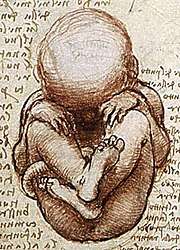Middle age
Middle age is the period of age beyond young adulthood but before the onset of old age.[1]
| Part of a series on |
| Human growth and development |
|---|
 |
| Stages |
| Biological milestones |
| Development and psychology |
|
Definitions
According to the Oxford English Dictionary middle age is between about 45 and 65:[2] "The period between early adulthood and old age, usually considered as the years from about 45 to 65." The US Census lists the category middle age from 55 to 65. Merriam-Webster lists middle age from about 45 to 64,[3] while prominent psychologist Erik Erikson saw it starting a little earlier and defines middle adulthood as between 55 and 65. The Collins English Dictionary lists it between the ages of about 40 and 60,[4] and the Diagnostic and Statistical Manual of Mental Disorders – the standard diagnostic manual of the American Psychiatric Association – used to define middle age as about 55 to 60, but as of DSM-IV (1994) revised the definition upwards to about 55 to 65. A study in prestigious medical journal The Lancet, published in July 2020, defined "mid-life" as being 45–65 years.[5]
Young adulthood
This time in the lifespan is considered to be the developmental stage of those who are between 18 years old and 45 years old. Recent developmental theories have recognized that development occurs across the entire life of a person as they experience changes cognitively, physically, socially, and in personality.[1][6]
Middle adulthood
This time period in the life of a person can be referred to as middle age. This time span has been defined as the time between ages 45 and 65 years old.[1][2] Many changes may occur between young adulthood and this stage.[7][8] The body may slow down and the middle aged might become more sensitive to diet, substance abuse, stress, and rest. Chronic health problems can become an issue along with disability or disease. Approximately one centimeter of height may be lost per decade.[7] Emotional responses and retrospection vary from person to person. Experiencing a sense of mortality, sadness, or loss is common at this age.[9]
Those in middle adulthood or middle age continue to develop relationships and adapt to the changes in relationships. Changes can be the interacting with growing and grown children and aging parents. Community involvement is fairly typical of this stage of adulthood,[9] as well as continued career development.
Physical characteristics
Middle-aged adults may begin to show visible signs of aging.[7] This process can be more rapid in women who have osteoporosis. Changes might occur in the nervous system. The ability to perform complex tasks remains intact. Women experience menopause in the years surrounding the age of 50, which ends natural fertility.[10] Menopause can have many side effects, some welcome and some not so welcome. Men may also experience physical changes. Changes can occur to skin and other changes may include decline in physical fitness including a reduction in aerobic performance and a decrease in maximal heart rate. These measurements are generalities and people may exhibit these changes at different rates and times.
The mortality rate can begin to increase from 45 and onwards, mainly due to health problems like heart problems, cancer, hypertension, and diabetes.[9][11] Still, the majority of middle-aged people in industrialized nations can expect to live into old age.
Cognitive characteristics
Erik Erikson refers to this period of adulthood as the generativity-versus-stagnation stage. Persons in middle adulthood or middle age may have some cognitive loss. This loss usually remains unnoticeable because life experiences and strategies are developed to compensate for any decrease in mental abilities.[8]
Social and personality characteristics
Marital satisfaction remains but other family relationships can be more difficult. Career satisfaction focuses more on inner satisfaction and contentedness and less on ambition and the desire to "advance".[9] Even so, career changes often can occur. Middle adulthood or middle age can be a time when a person re-examines their life by taking stock, and evaluating their accomplishments. Morality may change and become more conscious. The perception that those in this stage of development of life undergo a "mid-life" crisis is largely false. This period in life is usually satisfying, tranquil. Personality characteristics remain stable throughout this period.[1] The relationships in middle adulthood may continue to evolve into connections that are stable.[9]
References
- "PsycNET - Option to Buy".
- "Middle Age: definition of middle age in Oxford dictionary (American· English) (US)". Oxforddictionaries.com. Retrieved 2016-06-15.
- "Definition of MIDDLE AGE".
- Middle age. CollinsDictionary.com. Collins English Dictionary – Complete & Unabridged 11th Edition. Retrieved December 05, 2012.
- "Dementia prevention, intervention, and care: 2020 report of the Lancet Commission". The Lancet. 30 July 2020. Retrieved 11 August 2020.
- Erik H. Erikson, Joan M. Erikson, The Life Cycle Completed: Extended Version (W. W. Norton, 1998),
- "Osteoporosis Tests and Diagnosis".
- Gordon-Salant, Sandra; Frisina, Robert D.; Fay, Richard R.; Popper, Arthur (3 May 2010). The Aging Auditory System. Springer Science & Business Media. ISBN 9781441909947 – via Google Books.
- Stern, Theodore (2016). Massachusetts General Hospital comprehensive clinical psychiatry. London: Elsevier. ISBN 978-0-323-29507-9. Access provided by the University of Pittsburgh.
- Bourgeois, F. John; Gehrig, Paola A.; Veljovich, Daniel S. (1 January 2005). Obstetrics and Gynecology Recall. Lippincott Williams & Wilkins. ISBN 9780781748797 – via Google Books.
- "Products - Data Briefs - Number 193 - March 2015".
Further reading
- Barbara Bradley Haggerty (2016). Life Reimagined: The Science, Art, and Opportunity of Midlife. Riverhead Books. ISBN 978-1594631702.
- Lachman, M. E. (Ed.). (2001). Handbook of midlife development. NY: John Wiley.
- Lachman, M. E., Salom, T., & Agrigoroaei, S. (2015). Midlife as a pivotal period in the life course: Balancing growth and decline at the crossroads of youth and old age. International Journal of Behavioral Development, 39. 20-31. doi: 10.1177/0165025414533223